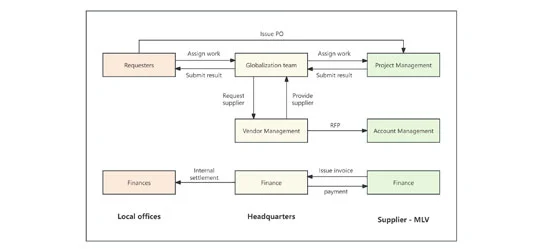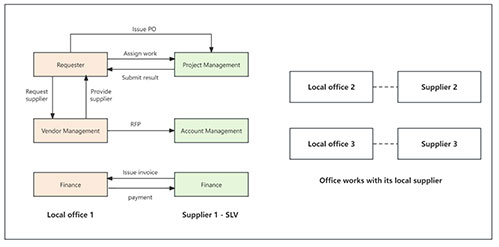In today's global marketplace, the life science industry is no stranger to the complexities of managing translations across multiple languages. As these companies expand their reach into diverse markets, they face a crucial decision – should they centralize their translation efforts at their headquarters or decentralize the process to their local offices in target markets? In this article, we'll delve into these two models and compare their advantages and disadvantages, helping life science companies make informed decisions when it comes to managing their life science document translations needs.

In a centralized model, all translation activities are coordinated and managed by the corporate headquarters. When a local office, such as a pharmaceutical or medical device registration applicant, needs translation services, they submit their request to the globalization team at the headquarters.
Upon receiving the request, the globalization team checks its existing vendor network to identify suppliers capable of meeting the demand. If no suitable vendor is available, the vendor management team at the headquarters initiates a request for proposal (RFP) process to find new suppliers. Once a suitable vendor is identified, the vendor management team recommends them to the globalization team. Typically, these selected suppliers offer multilingual translation services, often referred to as Multilingual Language Vendors (MLVs).
The globalization team then contacts the supplier's project management team to allocate the translation project. The supplier's project management team undertakes the translation, completes the project, and delivers it to the globalization team. The globalization team reviews the final translation before submitting it to the requester.
Regarding the financial process, when assigning projects to suppliers, the supplier quotes for the work based on the project's scope. Once the globalization team approves the quote, a Purchase Order (PO) is issued to the supplier. After project completion, the supplier's financial team submits an invoice, and the corporate finance department at the headquarters processes the payment. Post-project completion, the corporate finance department reconciles the accounts with the local office's finance team.
In this model, it's important to note that all translation workflow and vendor management responsibilities are centralized at the corporate headquarters. Local offices are primarily responsible for submitting translation requests and making payments. This is known as centralized translation management.

In contrast, decentralized translation management omits the central headquarters from the equation. When a translation need arises, the requester directly communicates with the local supplier management department or, if they already have established suppliers, contacts these vendors. Typically, these suppliers primarily provide single-language translation services, known as Single Language Vendors (SLVs).
Suppliers quote for the work based on the requester's job requirements. Upon approval, the requester issues a PO. After project completion, the supplier team submits the translation to the requester for inspection. The requester checks the work, decides whether to accept it, and the supplier submits an invoice. Payment is then processed by the local office's finance department. In a decentralized model, each local office independently manages its translation requirements, relying on local supplier relationships to fulfill its needs.
So, which approach, centralized or decentralized, offers the most advantages, and what are their respective drawbacks? Let's explore these dimensions in the sections to follow.
Comparing centralized and decentralized management, decentralized approaches eliminate intermediary communication layers, enhancing communication efficiency. In a decentralized model, requesters can convey their specific needs, background information, reference information, and any other critical details directly to the suppliers. Suppliers can likewise address project issues directly with the requesters, and since there are typically no time zone differences, rapid responses to queries are achievable.
In a centralized management model, participants in the globalization team possess in-depth knowledge of language translation and are experts in the field. They establish quality standards, track translation projects, and monitor quality scores objectively. Based on these quality scores, quality management of suppliers is implemented, resulting in effective quality assurance and long-term stability in translation quality.
In contrast, in the decentralized model, quality management becomes a challenge. Those involved in translation projects, whether pharmaceutical or medical device registration applicants or local company supplier management personnel, typically lack expertise in translation. This can lead to varying interpretations of translation quality, resulting in inconsistent translation quality and higher quality risks.
In summary, the quality in centralized management is superior to that in decentralized management.
Language assets generally encompass Translation Memories, Terminology, Translation Style Guides, Bilingual Files, and other resources used for translation management and post-translation maintenance. These assets are crucial for maintaining translation quality, reducing translation costs, and establishing a consistent translation style. To leverage the benefits of language assets, meticulous maintenance and management are required.
In centralized management, the language assets are managed by the globalization team. However, in a decentralized management model, usually, nobody is responsible for these assets, and many people may not even be familiar with these terms.
Over the years, various translation technologies, such as Computer-Assisted Translation (CAT), Translation Management Systems (TMS), Machine Translation (MT), and Quality Assurance (QA) tools, have been successfully integrated into the translation process. With their implementation, the efficiency of translation and management has significantly improved. Companies that have successfully introduced new technologies into translation management have greatly benefited from them.
In this aspect, centralized management possesses inherent advantages. It can efficiently manage the entire company's translation needs, allocate dedicated personnel for research and development of technology, and gradually apply these advancements to their translation projects.
Decentralized management, on the other hand, faces significant challenges in implementing these technological tools. For example, a company headquarters may purchase a TMS software and integrate it into the company's server, requiring local offices to manage their translation projects in the TMS. However, since translation management is decentralized, there is no strong control by the headquarters. Local requesters still contact their suppliers offline to request quotes, schedule work, and submit translations. Only project information is recorded in the TMS after the project is completed. This can result in the investment in purchasing the TMS being less effective.
Regarding the trend of technology in translation, we have observed that:
It is still a hot topic to effectively integrate existing technologies into a company's translation process.
Exploring the application of new AIGC technology in translation to save costs.
In any case, the implementation of technology requires strong control across languages, which depends on centralized management.
After this comprehensive comparison, it becomes evident that both models have their distinctive characteristics. Generally, decentralized management is suitable for single language, irregular requirements, and when no language experts are involved in management. On the other hand, centralized management works well for multilingual, regular translations, and when long-term management benefits are expected.
Which model is more suitable for your enterprise also depends on various factors, such as your current priorities, budgets, talent teams, and technology support. If you'd like to gain further insights tailored to your specific situation, please don't hesitate to reach out to us at contact@willingjet.com.